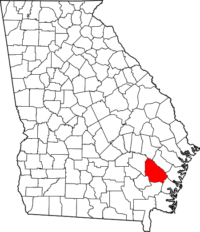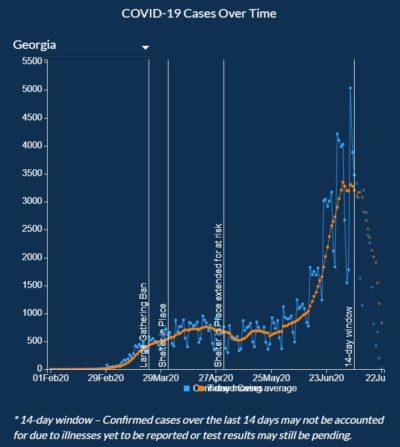
Caption
Wayne Memorial Hospital in Jesup has just 12 critical care beds. Wayne County has some of the highest case rates of COVID-19 in the country. / Wayne Memorial Hospital
Credit: Wayne Memorial Hospital

Wayne Memorial Hospital in Jesup has just 12 critical care beds. Wayne County has some of the highest case rates of COVID-19 in the country. / Wayne Memorial Hospital
The most recent COVID-19 hot spot in Georgia has been identified after an outbreak at a federal prison.
Wayne County, in southeast Georgia, has the 10th-highest rate among U.S. counties of cases per resident, according to figures reported by the New York Times.

FCI Jesup is a medium security federal correction institute in Wayne County. / U.S. Board of Prisons
That’s been driven by FCI Jesup, a federal prison in the county that has more than 200 COVID-19 cases, including 15 staff members.
Joe Ierardi, CEO of 84-bed Wayne Memorial Hospital, said Wednesday that his facility has seen many patients from the prison and the community since July.
“Locally, in March and April, we kind of were spared,’’ he told GHN. “Over the last month, it’s been our turn.’’

Wayne County is located in the southwestern portion of the state. / State of Georgia
The rural hospital has just 12 critical care beds, and therefore many patients have been sent to Savannah hospitals for care, Ierardi said.
The community has pitched in: A local sewing factory made 600 isolation gowns, which are washable and reusable, Ierardi said. “We’ve been using them 20 to 25 times.’’
Statewide, the Georgia Department of Public Health on Wednesday reported a single-day increase in deaths of 81. That’s the largest single-day increase in deaths since 86 were reported April 20, the Macon Telegraph said. The state reported 78 deaths Tuesday.
Public Health officials say the higher numbers of deaths reflect the recent surge in hospitalizations and cases of COVID-19 across the state.
How the state illustrates its pandemic statistics continues to draw criticism from health and data experts.
The benchmarks for a state map on cases per 100,000 population keep changing as COVID-19 cases surge, leading to concerns that this may confuse the public.
The color-coded thresholds for Georgia coronavirus cases per 100,000 have risen at least three times since mid-April. The criteria for the most severely hit counties, depicted in red, increased from at least 200 cases per 100,000 to at least 2,224 per 100,000, critics say. This month, it’s risen from 2,961 to 3,302.

Georgia DPH map of COVID cases as of July 22, 2020. / Georgia Department of Public Health
And on Wednesday, the threshold went even higher, to 3,391.
Currently, the number of “red’’ counties remains low, at four out of 159, on the Department of Public Health’s website, as well as a map from the Georgia Emergency Management and Homeland Security Agency.
The four are thinly populated Chattahoochee, Stewart, Randolph and Echols counties.
The state’s website adds, “This chart is meant to aid understanding whether the outbreak is growing, leveling off, or declining and can help to guide the COVID-19 response.”
Matt Hayat, a biostatistics expert at Georgia State University’s School of Public Health, said the American Statistical Association’s ethical guidelines state that publications and reports should convey findings in ways “that are both honest and meaningful to the reader.’’
“The lack of transparency with assumptions about the data and analysis are very concerning and likely misleading for the public,’’ Hayat said. “The use in the daily situation report of altering groupings and thresholds over time obscures understanding of how the outbreak is changing.’’
Increasing the threshold of maximum severity does not reflect the accelerating spread of the disease recently, Hayat said.
A spokeswoman for Public Health, Nancy Nydam, said that the maps “are not designed to show increases over time, but rather to show density by location and differences between counties.’’

Nancy Nydam with the Georgia DPH said that the maps “are not designed to show increases over time, but rather to show density by location and differences between counties.’’ / Georgia Department of Public Health
They should not be compared to each other, she said. “If the ranges are not periodically reset, the entire map would end up one color and viewers wouldn’t be able to make distinctions between locations.’’
Trends over time are presented in the epi curve in the plots to the right of the map, Nydam added.
Hayat, however, said that curve is also misleading. At the far right, the curve “gives an impression of cases dropping. They aren’t.’’
Dr. Melanie Thompson, an Atlanta physician who has been a critic of the state’s handling of COVID-19, also said the map doesn’t reflect the current status of the pandemic.
“One reason is that they continue changing the scale, and the number of cases included in each band of color,’’ Thompson said. “I have seen counties increase their cases or case rates substantially, only to maintain the same color on the map because the scale changes. The map links to the epidemic graph, which is helpful, but of course the epidemic graph is backdated so it always looks like the most recent two weeks are getting better. None of the maps reflect the recent status of the counties.’’

Map of weekly changes in COVID positive rates provided by the White House Coronavirus Task Force. / White House Coronavirus Task Force
She pointed to maps used by the White House Coronavirus Task Force as better in tracking what is happening in recent weeks.
The state data presentation has taken flak previously.
This story comes to GPB through a reporting partnership with Georgia Health News